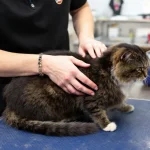First-time cat owners often encounter a learning curve as they adapt to caring for their new feline friend. Here are 11 common mistakes they may make:
- Not Providing Adequate Litter Box Care: Neglecting to clean the litter box regularly can lead to aversion issues or inappropriate elimination.
- Overfeeding or Underfeeding: Incorrect portion sizes can lead to obesity or malnutrition. Follow feeding guidelines provided by your veterinarian.
- Neglecting Veterinary Care: Skipping regular check-ups or vaccinations can lead to undetected health issues. Schedule vet visits as recommended.
- Not Providing Enough Mental Stimulation: Cats need mental stimulation to prevent boredom and behavioral problems. Offer toys, scratching posts, and interactive playtime.
- Ignoring Dental Care: Dental hygiene is crucial for a cat’s overall health. Neglecting dental care can lead to dental disease and other health issues.
- Not Understanding Cat Behavior: Misinterpreting cat behavior can lead to misunderstandings and stress. Learn to recognize signs of stress, fear, or illness.
- Not Cat-Proofing the Home: Failing to cat-proof your home can lead to accidents or ingestion of harmful substances. Secure toxic plants, chemicals, and small objects.
- Not Providing Proper Scratching Outlets: Cats need to scratch to maintain healthy claws and mark their territory. Offer appropriate scratching posts or pads.
- Forcing Social Interaction: Cats need time to adjust to new environments. Respect their boundaries and allow them to approach you on their terms.
- Inconsistent Training: Inconsistency in training can confuse cats and hinder progress. Use positive reinforcement techniques consistently.
- Not Spaying or Neutering: Failing to spay or neuter can contribute to overpopulation and behavioral issues. Spaying or neutering your cat is essential for their health and well-being.
By avoiding these common mistakes and educating yourself on proper cat care, you can ensure a smooth transition for both you and your new feline companion.






